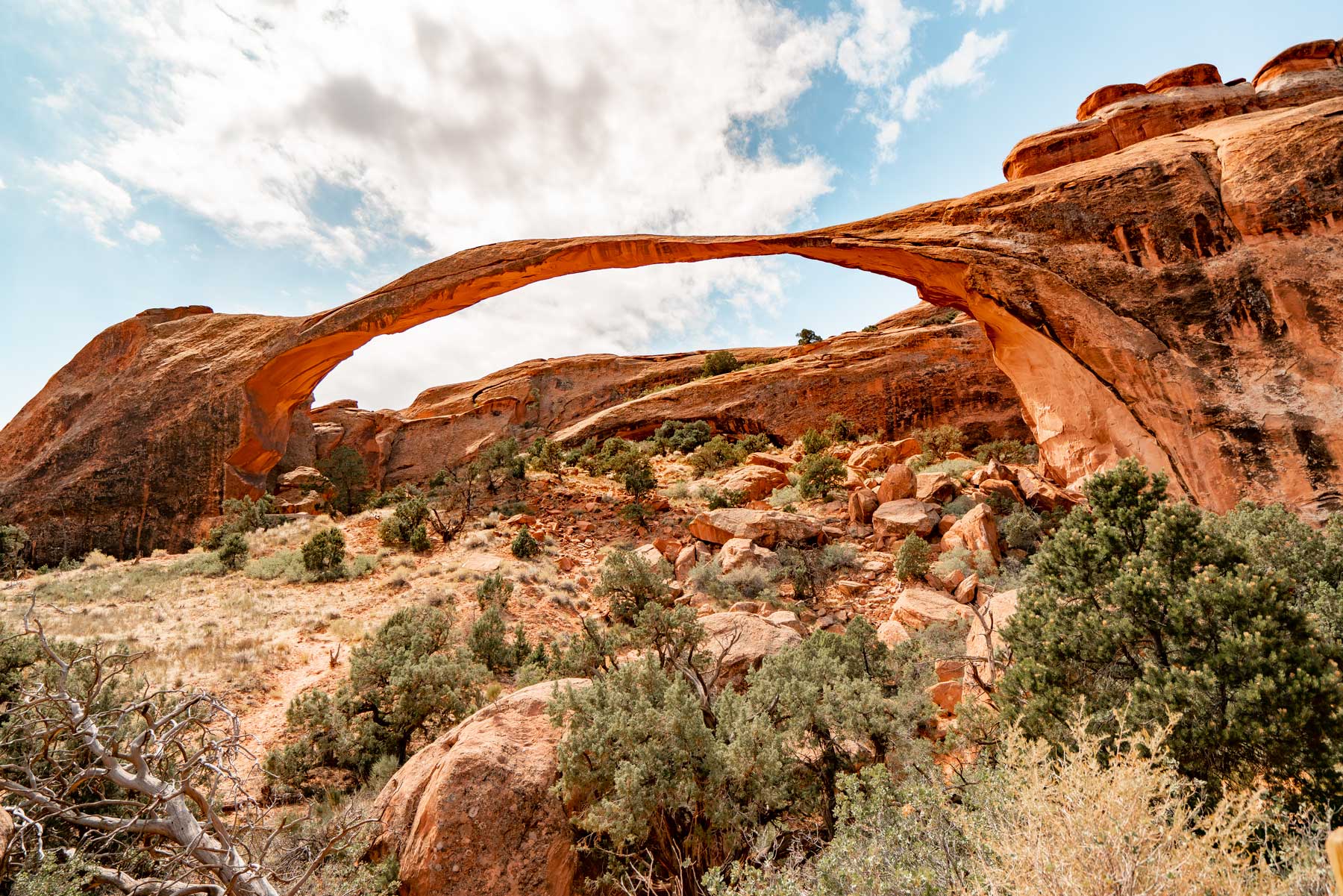
Article Overview: Devils Garden Hike in Arches National Park
The Devils Garden hike in Arches National Park offers a versatile hike for various experience levels, from a short trek to the world’s largest arch to a nearly eight-mile loop through expert-level terrain.
The Devil’s Garden trail is more than just seeing arches. It’s an easy maze of hidden arches, walking atop the sandstone fins and scrambling over exquisite, otherworldly terrain.
And there’s a Dark Angel along the way.
My name is Jennifer and I make a point to visit as many locations as possible with the words devil or hell in the name. These locations feel so raw and primal. The erosive structures around you at Arches are millennia-aged formations.
Arches National Park is one of Utah’s Mighty 5, alongside Bryce Canyon, Canyonlands, Capital Reef, and Zion. I’ve been to all five, and I can tell you that the devil is in the details when it comes to planning.
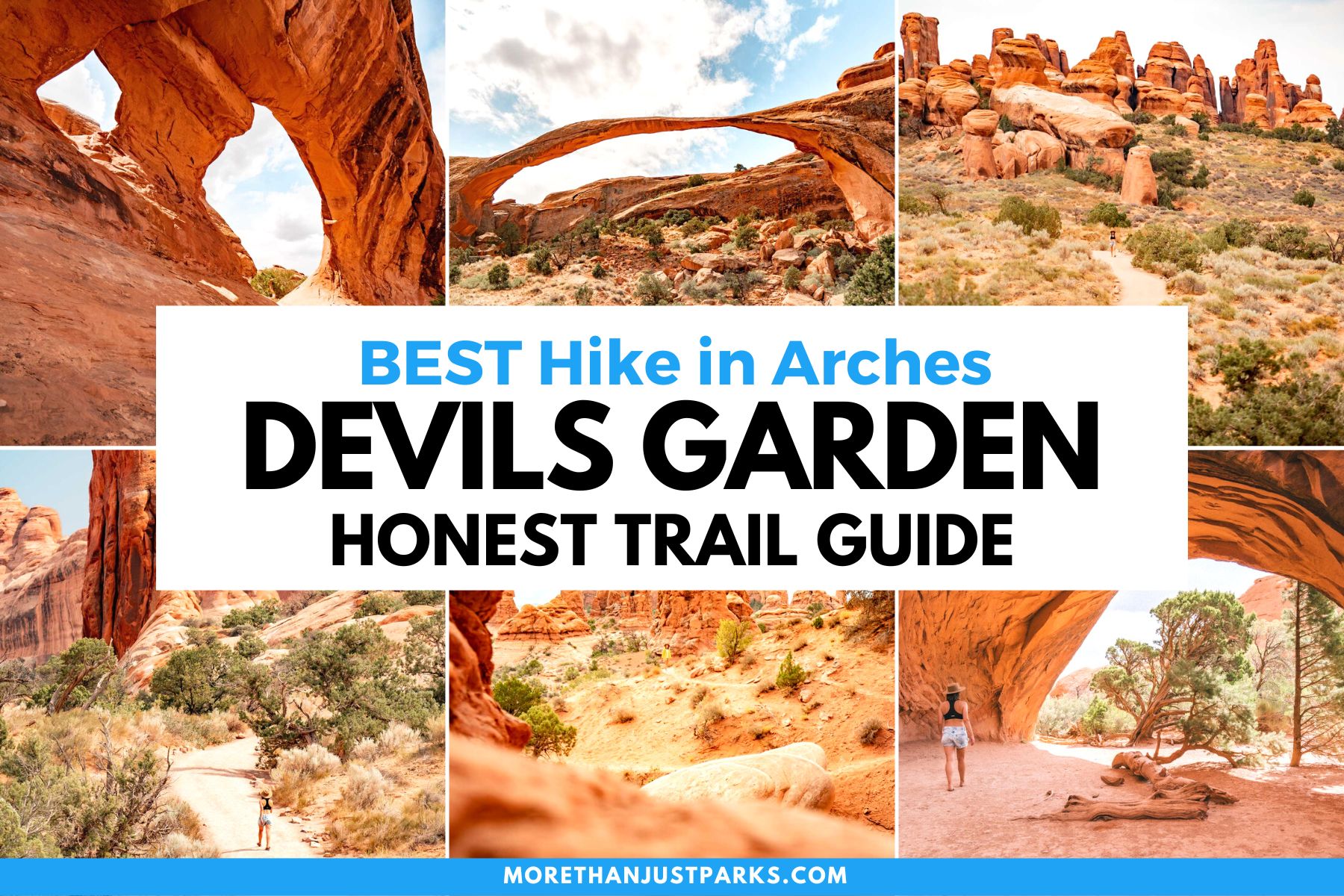
Devils Garden Hike in Arches National Park
Table of Contents: Devils Garden Hike in Arches National Park
- Devils Garden Hike in Arches National Park
- 5 Quick Things to Know About Devils Garden Trail
- Arch-by-Arch Devils Garden Hike
- Pine Tree Arch & Tunnel Arch
- Landscape Arch
- Partition Arch & Navajo Arch
- Black Arch Overlook & Double O Arch
- Dark Angel
- Primitive Trail and Private Arch
- Safety at Devils Garden Hike in Arches
- “What’s That?” Devils Garden Hike Formations
- FAQ: Devils Garden Hike in Arches
- Will Landscape Arch Be Protected from Collapse?
- Pin the Devils Garden Hike in Arches National Park
- More Helpful Related Articles
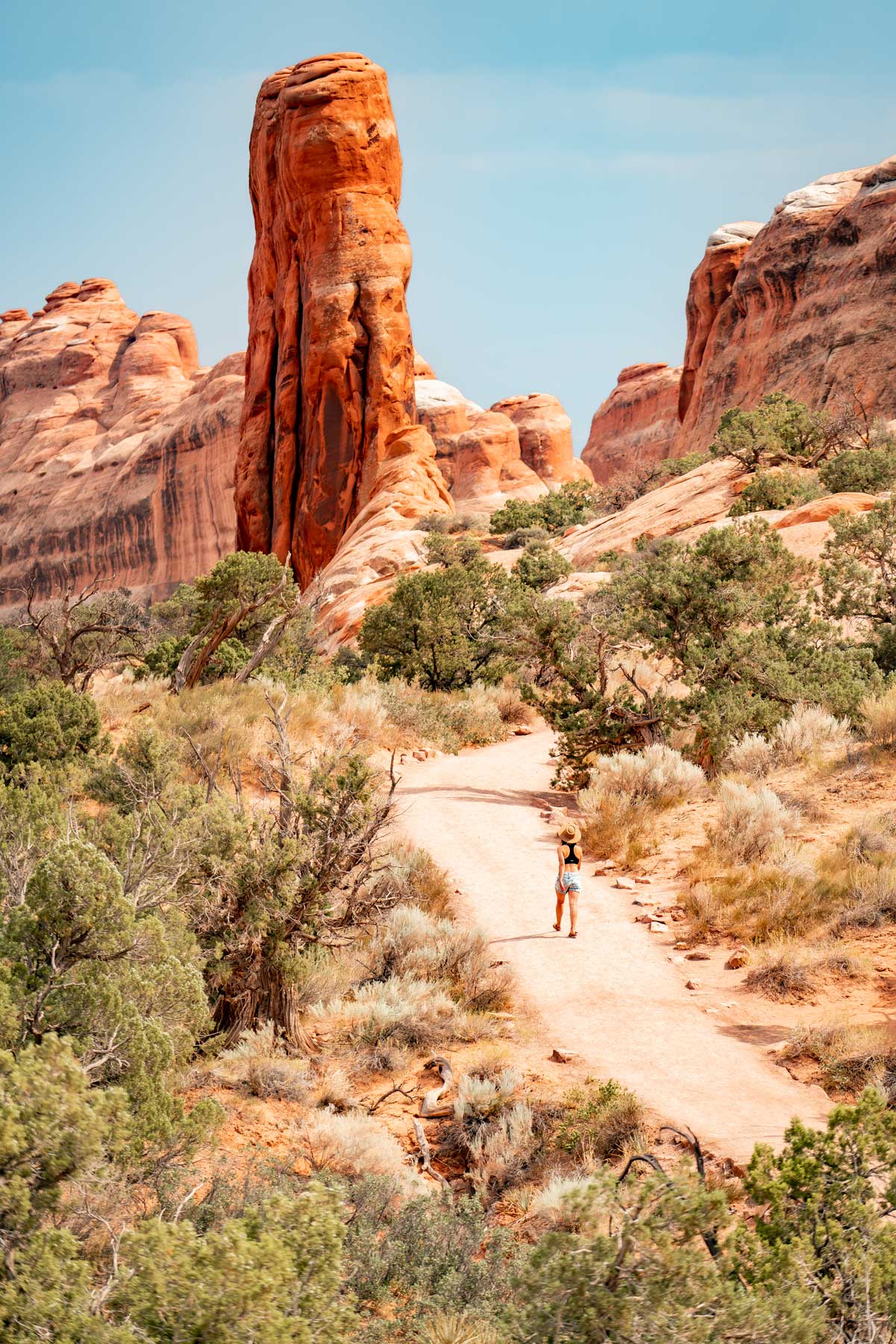
5 Quick Things to Know About Devils Garden Trail
- The entrance fee is $30 per person and $15 per vehicle. At the same time, the $80 America the Beautiful Pass gets you access to 2,000+ public lands for a year.
- So. Much. Sunscreen. The sun is intense year-round. I always have a bottle of this one with me.
- Arches is known for its gnarly gnats. Bring some bug spray to keep them at bay.
- If you’re looking for an affordable and close hotel, this is my top choice.
- I had a map and a guidebook to help me on the trail. I recommend you get them too.
Timed Entry Permit at Arches
Arches National Park is one of growing number of national parks that require reservations of some kind. Entering Arches National Park requires a permit from early April to October. During this time you must have a timed entry permit in order to access the park. These permit tickets are released 3 months in ahead of time so be sure to grab yours before you go (an example – permits for all of August are released on May 1).
Further Reading: All the National Parks that Require Reservations (UPDATED)
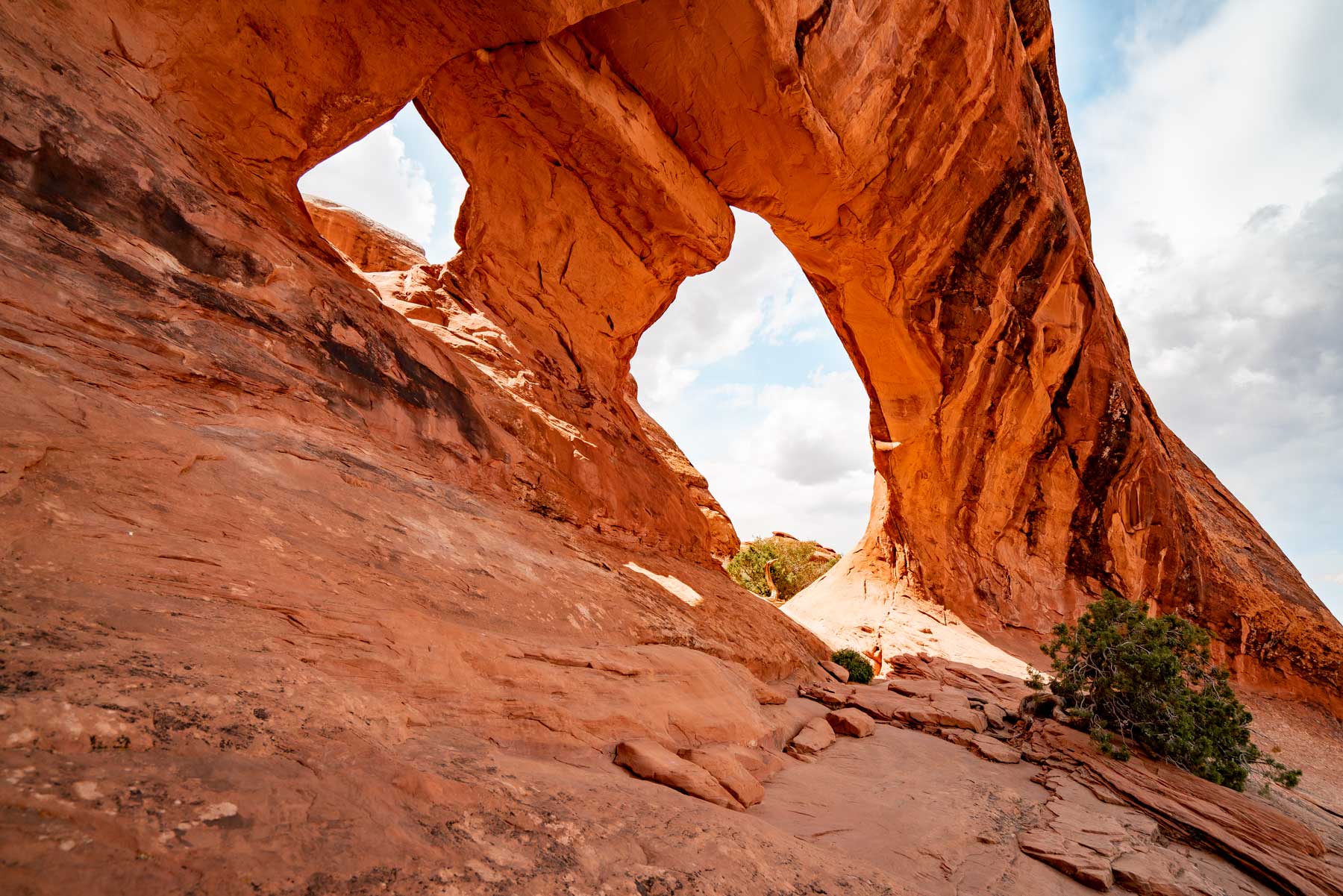
The Layout of Devils Garden Hike in Arches
Devils Garden hike in Arches National Park is a loop with several spur trails that add up to a 7.9 roundtrip hike. However, it’s only a loop if you opt to use the Primitive Trail, which requires scrambling and sliding down sandstone.
You can use the arches as benchmarks along the way to cut your hike shorter if need be.
| Devils Garden Hike | Distance | Difficulty | Options | |
| Trailhead to Landscape Arch | 1.9 miles out and back | Easy | Spur trails to Pine Tree Arch and Tunnel Arch add 0.5 miles. | |
| Trailhead to Double O Arch | 4.1 miles out and back | Moderate | Spur trails to Navajo Arch and Partition Arch add 0.8 miles. | |
| Trailhead to Dark Angel | 4.9 miles out and back 6.6 miles via Primitive Trail | Moderate/Strenuous | Dark Angel is a spire, not an arch. | |
| Trailhead through all spur trails and Primitive Trail | 7.9 miles | Strenuous | Reconsider Primitive Trail when it’s wet, snowy, or icy. |

For those taking the full loop of Devils Garden hike, you’ll come to the fork in the trail about .8 miles.
Most people choose to go clockwise, where you’ll pass the most arches early on and then tackle the toughest part of the trail halfway through.
You can go counter-clockwise, but you’ll face the toughest part of the Devils Garden hike first, AND you’ll have to tackle it going uphill. At least coming from the other direction, you’re going down.
Trails Markers In Devils Garden
You’ll find helpful trail markers along the way in several forms.
- Arch/Trail Signs: Standard signs telling you how far something is from your current location.
- End of Trail Signs: Sometimes, you don’t know if the trail keeps going.
- Wooden Fences: When you’re standing by a wooden fence, you’re on an easy part of the trail.
- Cairns: The Primitive Trail becomes the invisible trail in some spots, and the cairns are lifesavers. Some are pretty small, so keep an eye out.

Map of Devils Garden Hike in Arches
Arch-by-Arch Devils Garden Hike
Pine Tree Arch & Tunnel Arch
Towering cliff walls rise above you on the first stretch of the trail. After the canyon walls spit you out onto a wider section of the Devils Garden hike(0.2 miles), you’ll come to the spur trail for Pine Tree Arch and Tunnel Arch.
You can walk through Pine Tree Arch, but Tunnel Arch is only visible in the distance. Take note of the unique trees and shrubs along the way, and keep an eye out for the lizards. They thrive in the hottest temperatures of the day.
How do trees grow out of rocks? Pinyon pines and Utah junipers are boss trees. They weave their roots deep into the rock in search of water. Junipers keep growing when toppled and can live to be 1,000 years old! Pinyon pines produce a nut that has fed generations on this otherwise barren land.
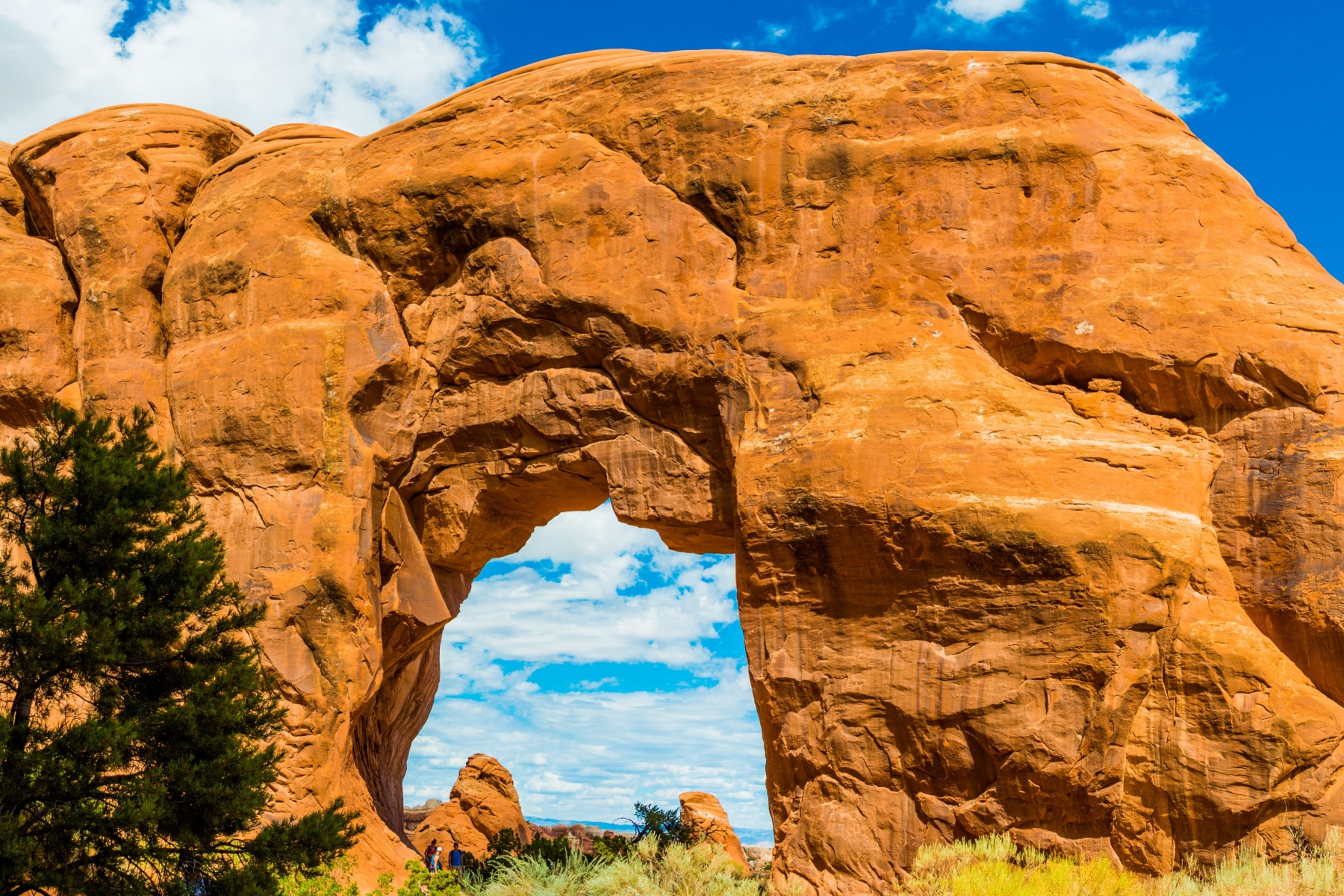
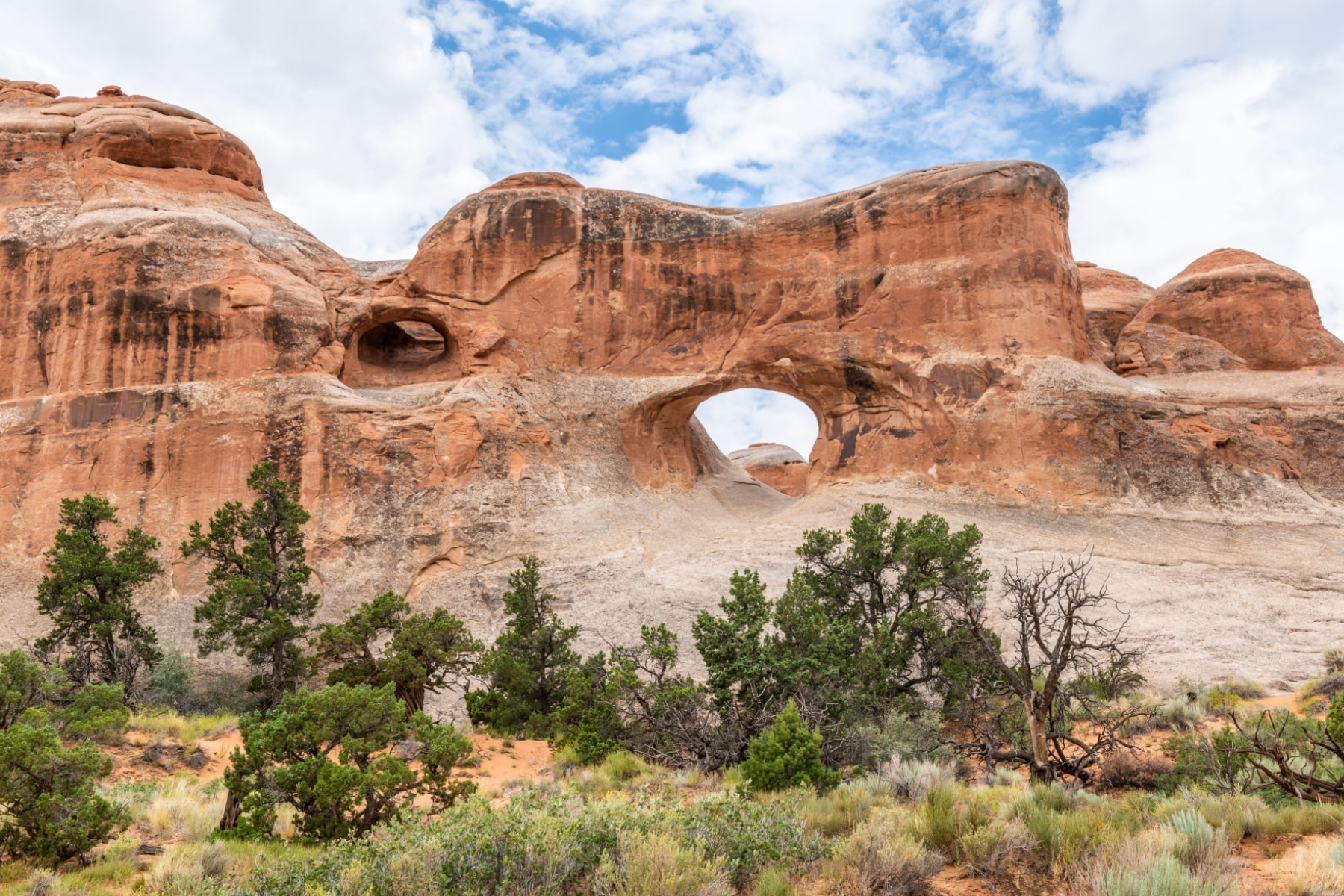
Landscape Arch
Half a mile from the spur trails, you’ll come to another fork in the road. As noted above, this spot marks the decision point to go clockwise or counterclockwise.
I chose clockwise and wouldn’t recommend trying it the other way unless you’re experienced at scrambling and navigating. Landscape Arch is in clear view for the 1,000-foot walk to the scenic lookout. This area is fenced-in and can get crowded. Walking to or under Landscape Arch is not allowed.
This is where the easiest section of the Devils Garden hike ends. From here, the hike will get more extreme with scrambling, narrow edges, and steep dropoffs. If you visit Landscape Arch as out-and-back, it’s 1.8 miles.
The Landscape Arch on the Devils Garden hike reigns as the longest arch in North America. The opening is 306 feet long, a full 21 feet longer than Kolob Arch in Zion National Park.

Partition Arch & Navajo Arch
Onward! The Devils Garden hike rises on a slickrock stretch, and you’ll walk right by where Wall Arch once stood before the collapse. At the top of the first incline, turn around and see one of the best scenic views on the trail thus far.
If you have trouble with this stretch, you will have a very hard time with the rest of the Primitive Trail.
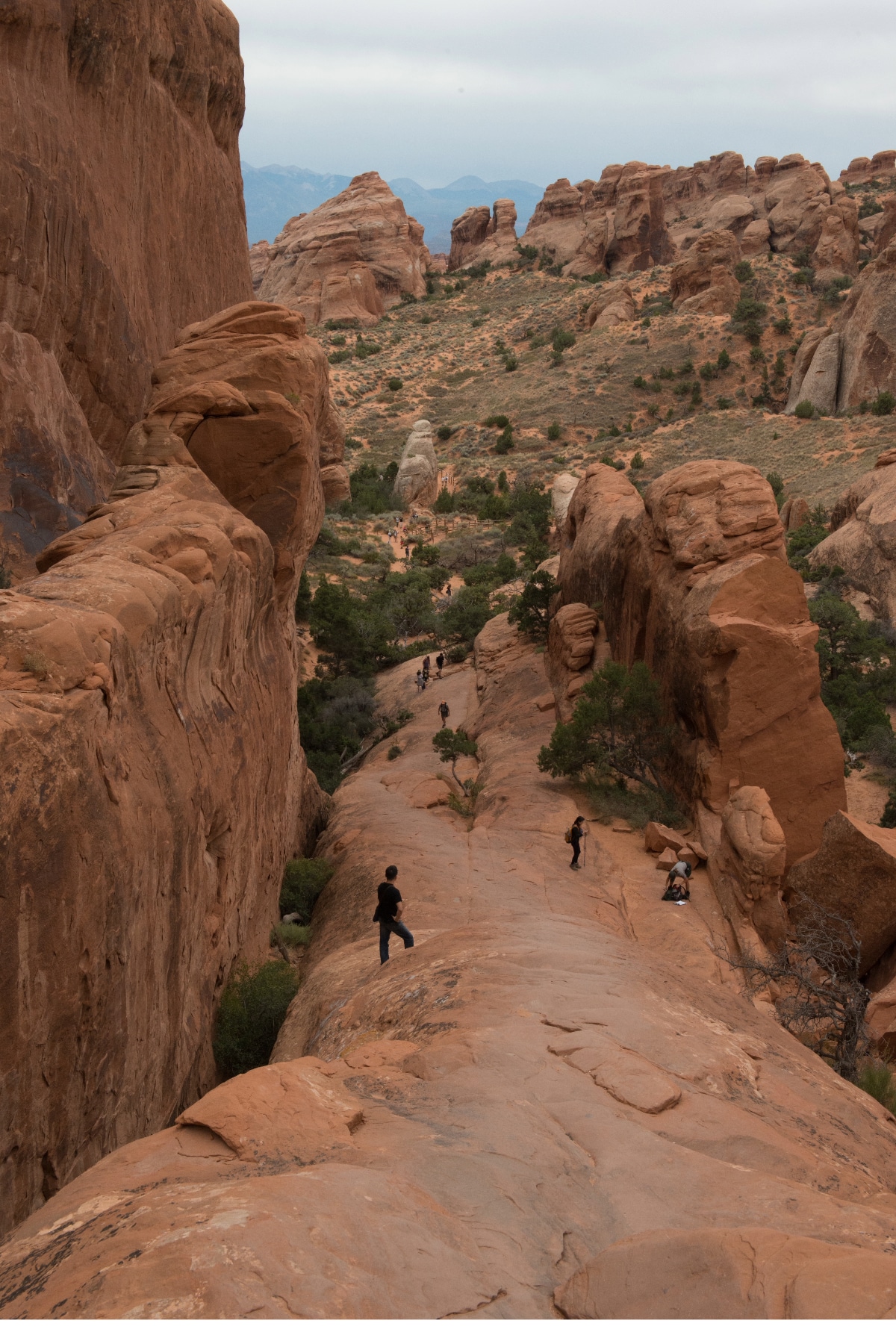
In just a few steps, you’ll come to another fork in the road for the spur trails to Partition Arch and Navajo Arch. This area can be confusing since paths seem to reach in many directions. There is a sign there, but you have to look closely for it. We almost missed it in the bright sun.
In the map below, you can see that Partition Arch and Landscape Arch share the same fin.
Partition Arch is cool for two reasons. First, it jumps out as you are on the Devils Garden hike, going from an intimating wall, and then suddenly, you’re looking at the wide opening and smaller window opening in Primitive Arch. The views from this arch are incredible.
Navajo Arch is hands-down my favorite arch in the park, and not just because there’s a little shade on the way. It’s another “HERE I AM” arch that pops up after 10 seconds after you’re sure you’re going the wrong way. Walk through this arch to see the amazing deep cavern (crevasse?) behind it. You’re in a secluded spot with towering walls.
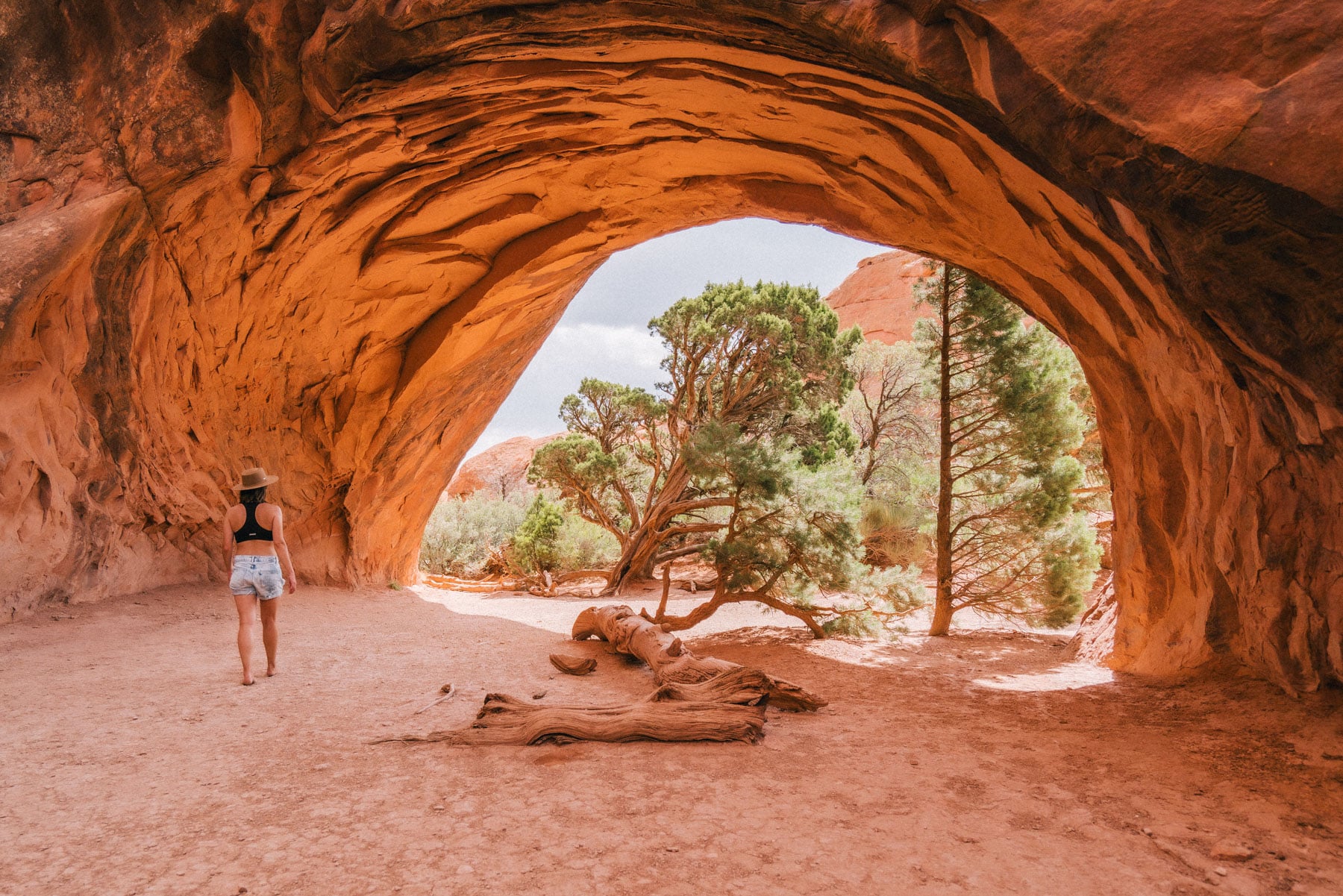

Black Arch Overlook & Double O Arch
The next half mile of Devils Garden hike in Arches made me repeatedly think I was lost. I heard this from several other (lost) hikers. You’ll walk across tall fins, giving you the first dose of vertigo if you are prone to it, and climb up some rock walls.
Black Arch Overlook
The markers on the Devils Garden hike here are nothing more than small poles with tiny arrows. Half a mile from the previous trail junction, you’ll reach Black Arch Overlook and see a small dark arch toward the bottom of the canyon. Go as far as you can walk on the trail to see it. If you don’t see it, you haven’t gone far enough.
Continuing on back to the main trail of Devils Garden hike, you’ve got another 0.3 miles before you reach Double O Arch. This section of trail is very dangerous when there is snow or ice.
Double O Arch
As I nicknamed it, this was the first “Sandpaper Slide,” where you can either precariously walk down slickrock or slide on your bottom. Weaving through the trial brought us in full view of the Double O’s. One is large, and the other is small, almost looking like a sloppy number 8 from certain viewpoints. You can scramble or climb these arches.
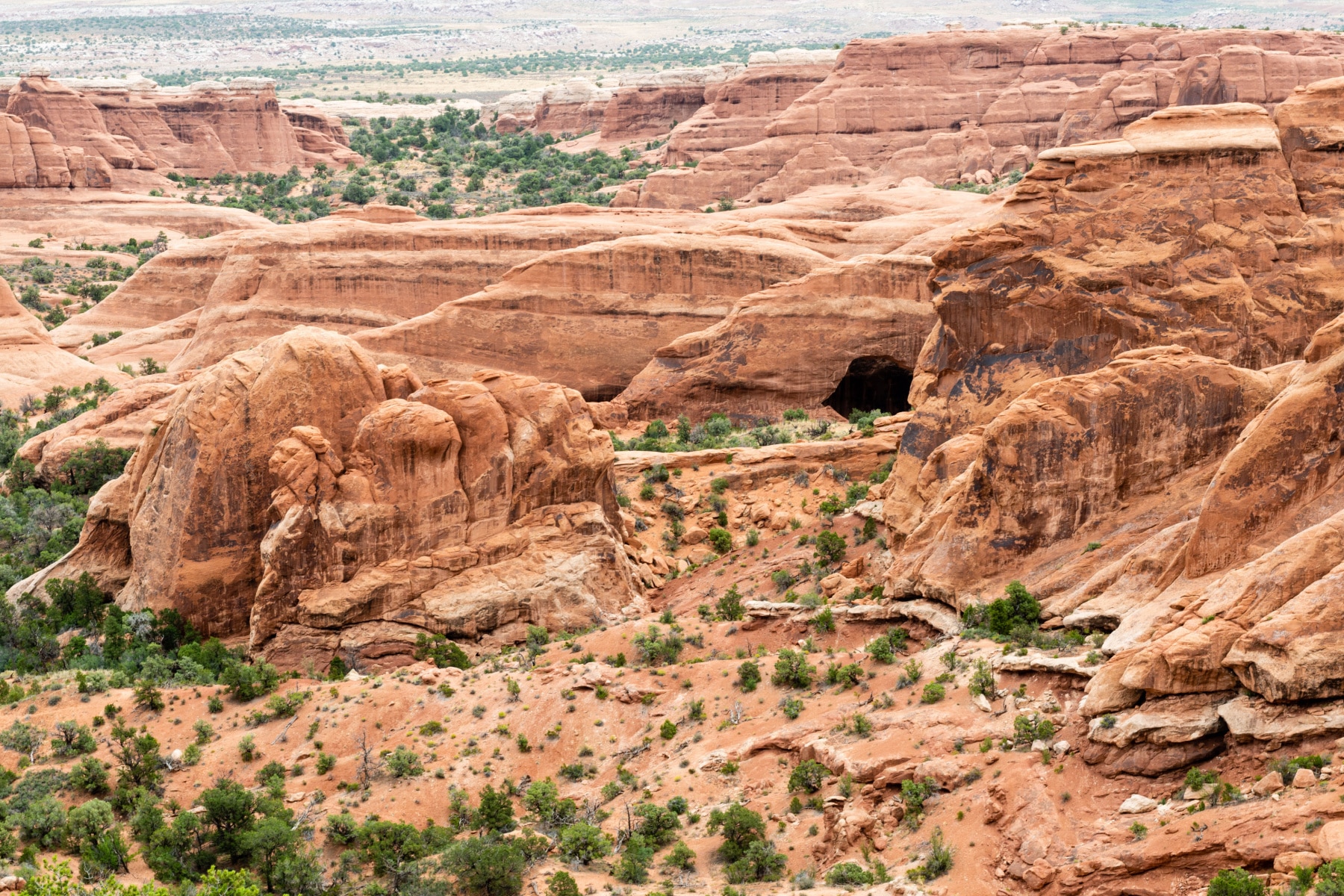
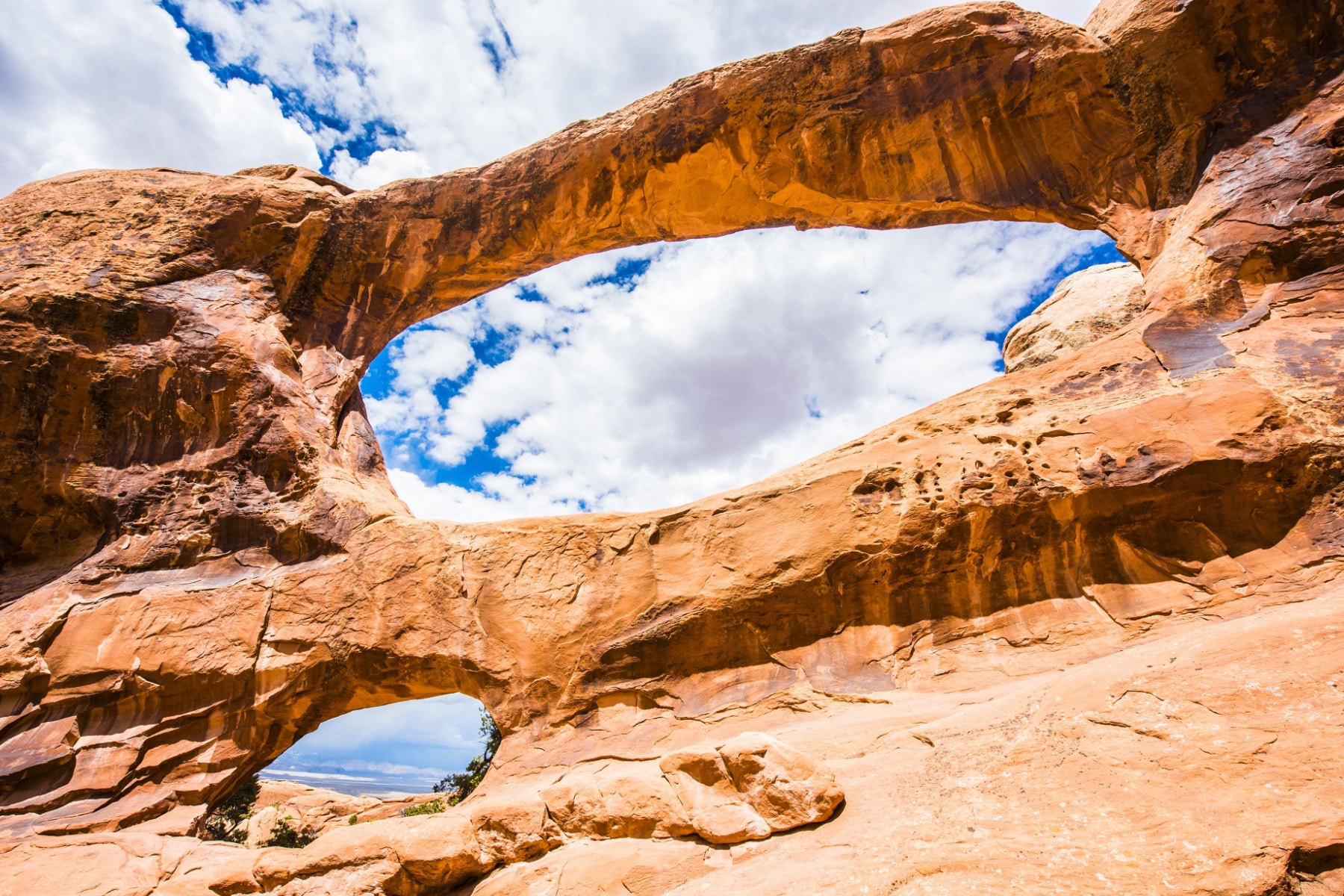
Dark Angel
Up next, the spur trail takes you to Dark Angel, about 0.5 miles off the trail. If there were one spur trail to skip, it would be this one. That said, go for the view as much as (if not more than) the 150-foot tower named Dark Angel. The spur trail ends at Dark Angel, and you can either go back the way you came on the Devils Garden hike or continue to the most challenging part of the Primitive Trail ahead.

Primitive Trail and Private Arch
Once you’re committed to the Primitive Loop, you’ll go another 0.5 miles before you come to the spur trail for Private Arch. Additionally, this is also where some will choose to climb up the rocks to get a view of Top Story Window, a hole high above you on a tall fin.
In my opinion, the 0.3 miles of the Private Arch Spur Trail have spires that are just as compelling as Dark Angel. The trail ends at Private Arch, where you can walk under and around it.
You won’t see any famous arches for about two miles on this part of the hike, but you’ll be eroding your energy levels as you slide on your bottom, jump across rock gaps, and teeter at the edge of steep dropoffs.
Watch Out for Water: Ephemeral water pools are common throughout this area, making scrambling and sliding a challenge to complete the task without ending up in the water. My shoes were a pumice of sand and water after sliding down slickrock into the water. Bring extra socks.
Finally, the last section of the path is nearly ankle-deep in the sand, and that sand is HOT in the summer. I’m pretty sure I still have sand dug into my hiking boots from that trail.
Once you complete the loop, you’re back near Landscape Arch, and just take the Devils Garden hike back to the parking area.



Getting to Arches National Park
Arches National Park is just north of Moab, Utah, in the remote southeastern section of the state. How remote?
- Salt Lake City: 230 miles
- Denver: 350 miles
- Las Vegas: 454 miles
Canyonlands Regional Airport in Moab sits just 20 minutes north of the park entrance, offering the easiest access to the park unless you love long road trips as much as I do.
With nearly 1.5 million people visiting Arches National Park each year, getting to the park is half the travel battle. Arches National Park started a timed-entry system implemented in April 2023 to reduce crowds and overflowing parking lots. Timed entry will continue in 2024 between April 1 and October 31.
Timed entry at Arches National Park runs from 7 am – 4 pm. Anyone arriving before 7 am or after 4 pm does not need a timed-entry ticket.
WATCH: See the crowded roads, parking lots, and trails that led to the time-entry program
Even once you’re in Arches National Park, you still have a 45-minute drive (18 miles) ahead of you to get to the Devils Garden hike trailhead. The parking lot has 160 spaces available, and even with timed entry, there’s no guarantee you’ll get a spot. The busiest times of the day are between 9 am and 1 pm.

Safety at Devils Garden Hike in Arches
As an experienced hiker, especially in desert climates, I prepare for the worst at all times (much to the dismay of my lower back). That’s what makes one of the risks on the Devils Garden hike a little unsettling. You can’t collaborate with erosion or gravity.
Those arches will fall eventually; don’t let their millennia of birthdays fool you. Hikers watched in horror in 1991 when part of the famed Landscape Arch crumbled. Two more rockfalls happened in 1995, leading to the closure of the trail that used to take you under the Landscape Arch.
About 0.2 miles up the Devils Garden hike from Landscape Arch, look for the two pillars where Wall Arch was until August 5, 2008, when a 71-foot gap was created by a thunderous fall heard from the campground.
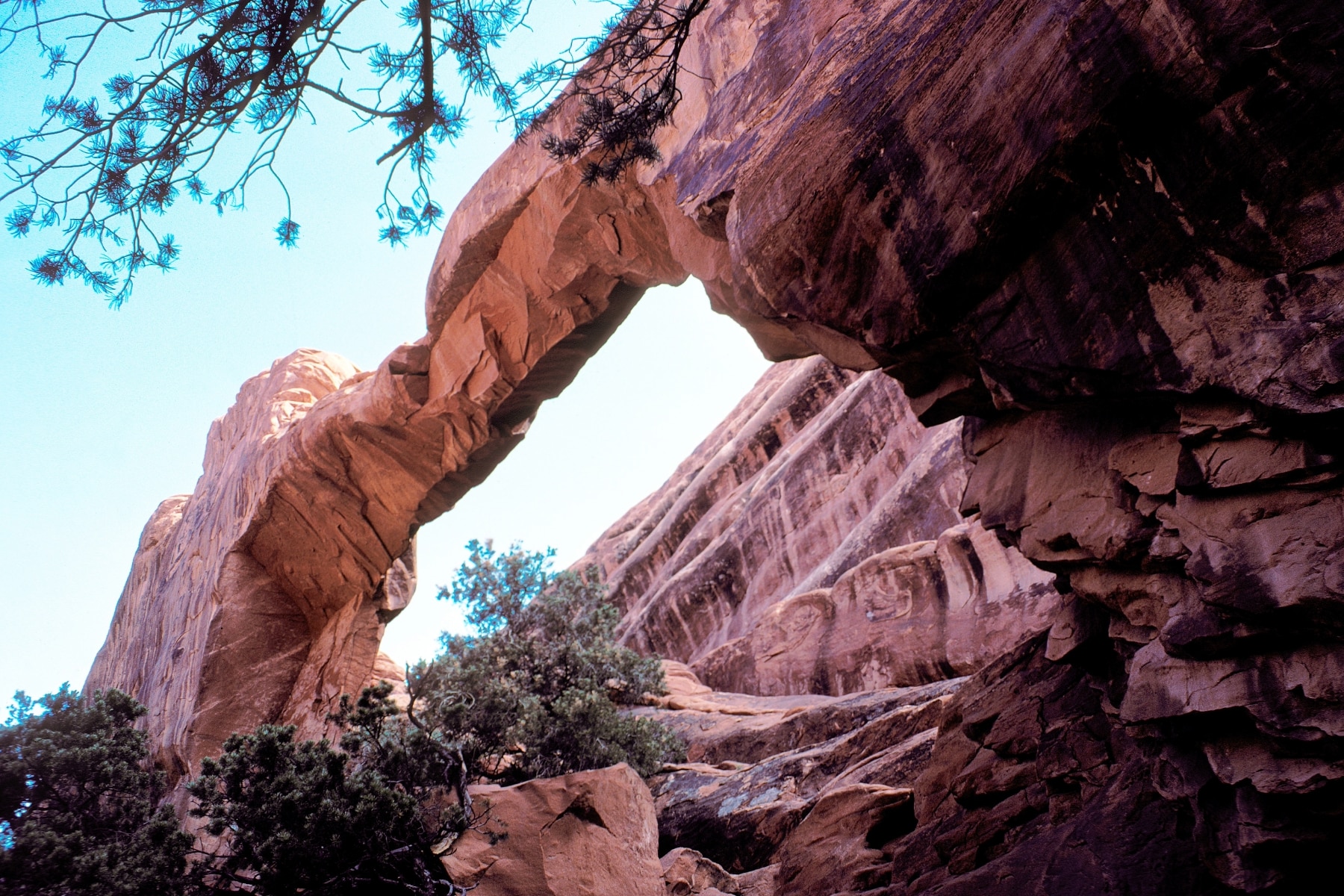
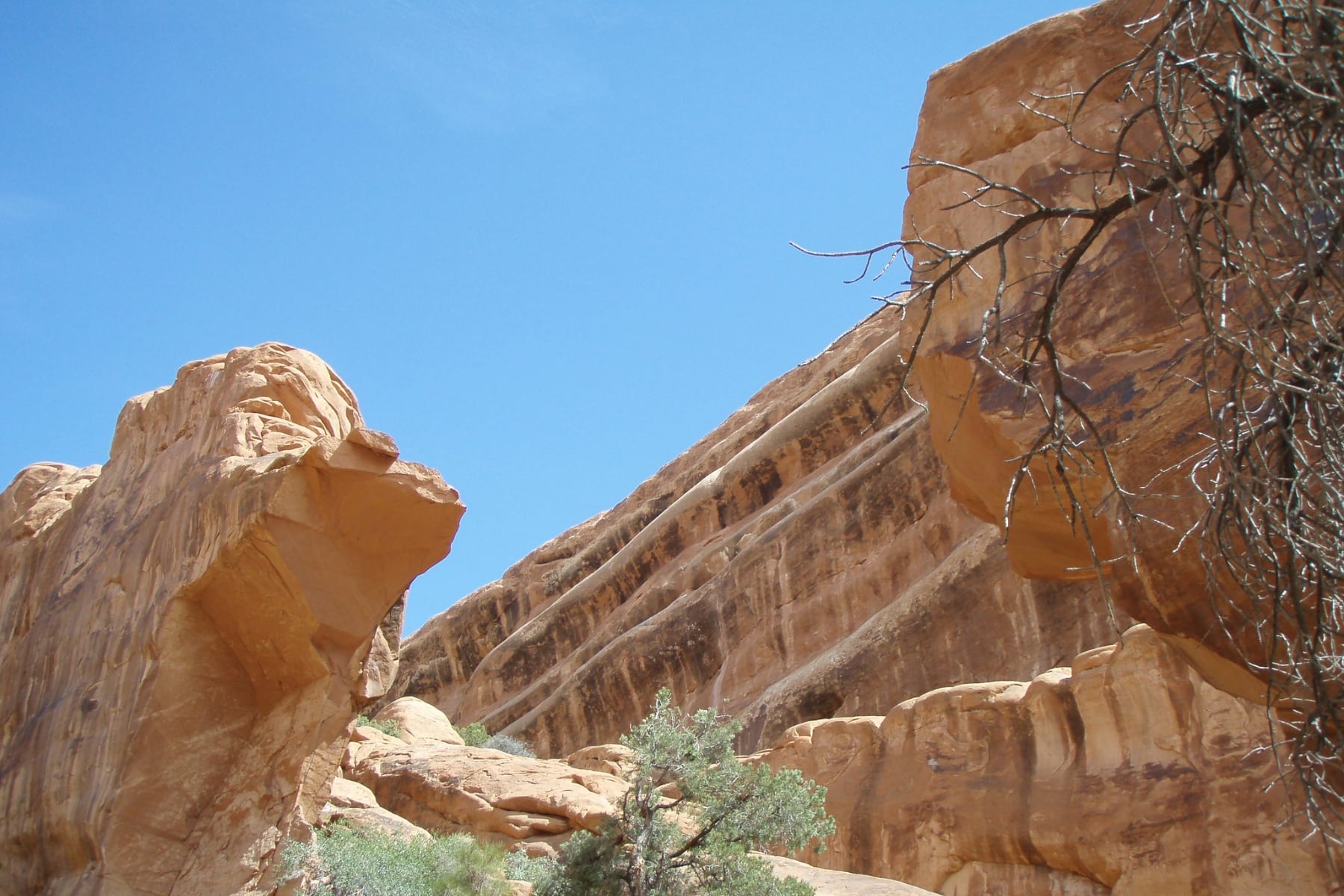
Personal Safety on Devils Garden Trail
No fresh water is available along the Devils Garden hike. Bring at least three liters with you to complete the full loop.
You should also avoid:
- Open-toed shoes
- Slick-bottomed shoes, like sneakers
- Hiking without checking the weather
- Drinking from Ephemeral Pools
“What’s That?” Devils Garden Hike Formations
By now, you know that Arches National Park is full of arches, right? Those arches started with the bedrock of Entrada and Slickrock Sandstone deposited more than 300 million years ago. Entrada Sandstone is much more susceptible to erosion than slickrock.
The wearing away of weak points mixed with freeze/thaw cycles in this extreme climate led to the creation of arches. Let’s go through some of the other features of Arches National Park.
Types of Formations
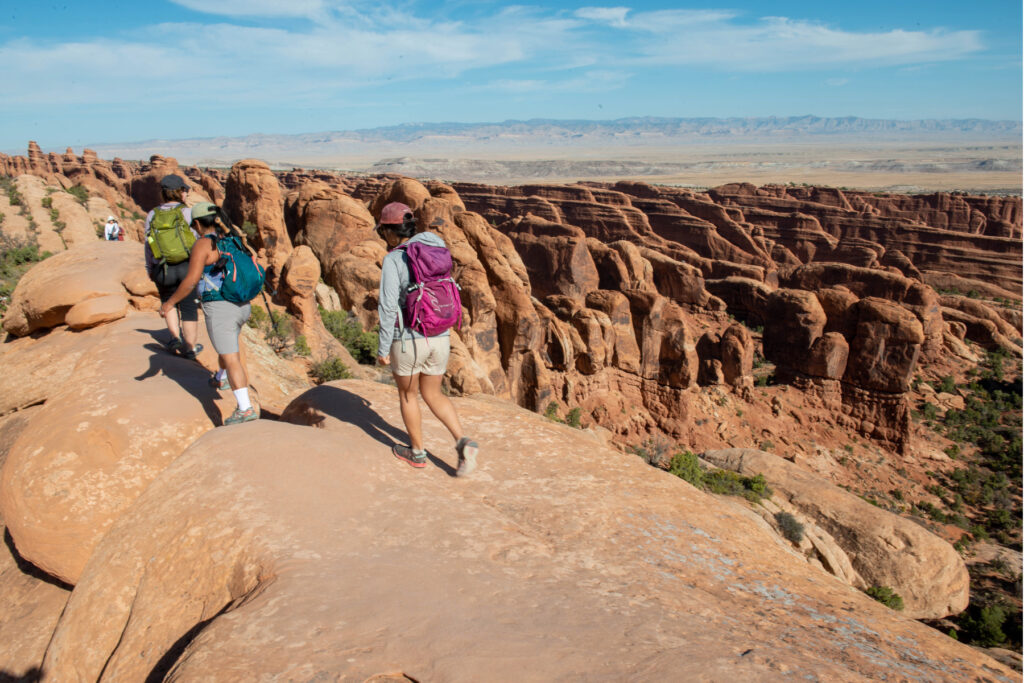
Fins
A fin is a tall, narrow ridge of resistant sandstone rock that protrudes vertically from the ground. Fins form over long periods of time when softer surrounding rock erodes away.
Natural Bridge
A natural bridge differs from an arch in that the opening is created by an “erosion valley” from the water below (like a river or stream).
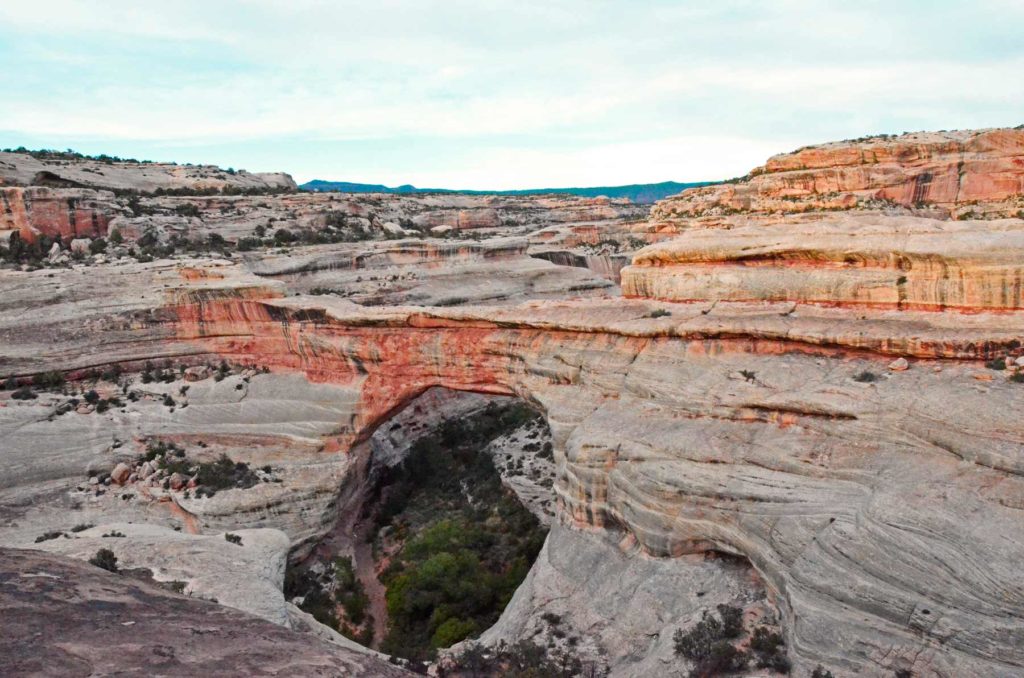
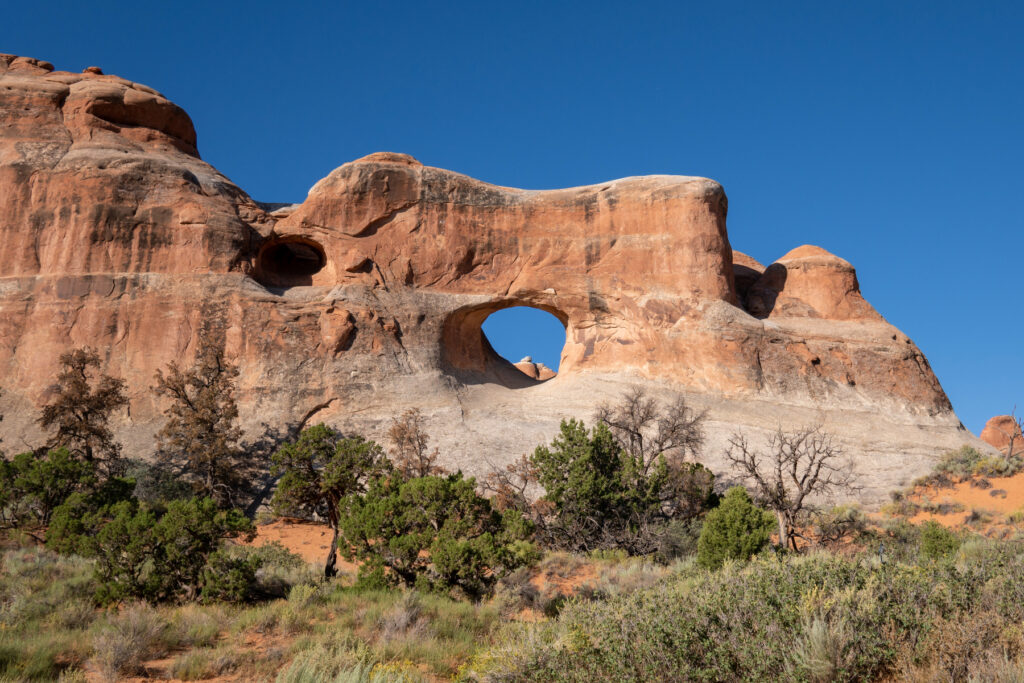
Windows
Windows are similar to arches but do not have a free-standing space underneath.
Hoodoos
Odd-shaped pillars of rock are left standing when softer rock erodes away around the fin. Hoodoos cluster in some areas. Bryce Canyon National Park has the “greatest concentration of hoodoos found anywhere on Earth.”
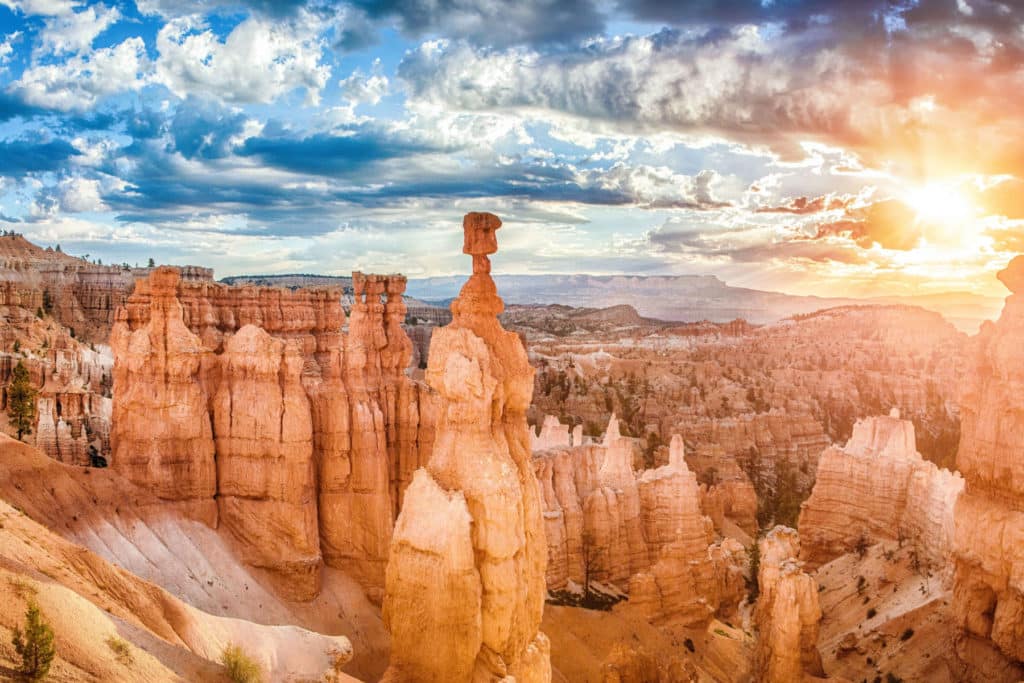
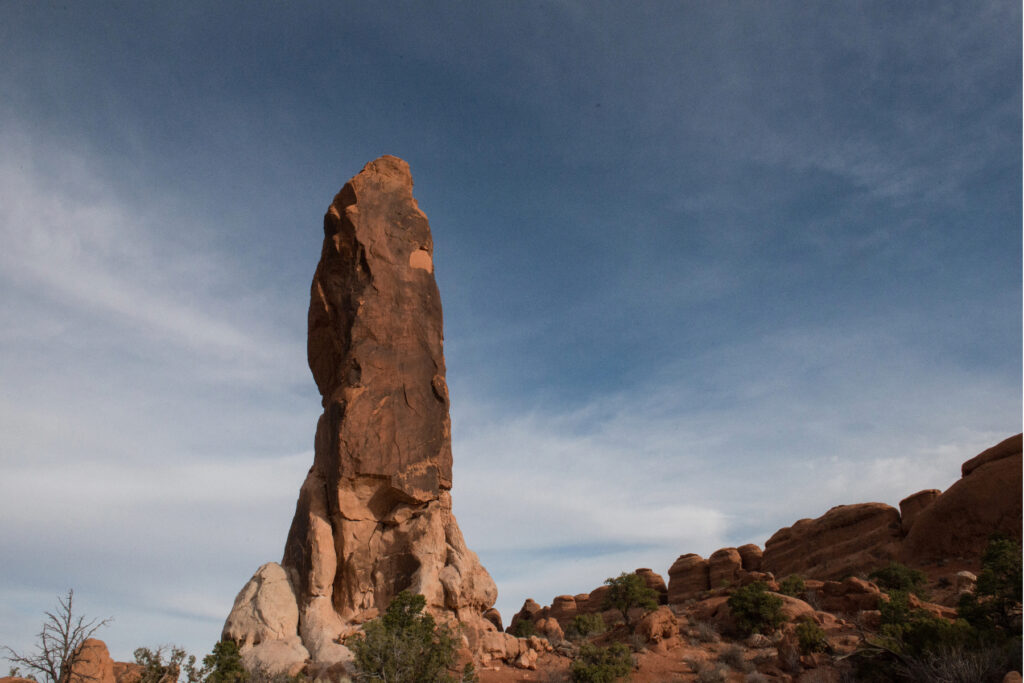
Spire
Spires form when a fin of resistant rock is left standing as softer surrounding rock erodes away over time.
Dark Angel is a spire on the Devils Garden hike in Arches. The darkened color is due to a process known as Desert Varnish.
Slickrock
Slickrock refers to expanses of bedrock with a smooth, polished appearance caused by wind and water eroding the surface over time.
Much of the Primitive Trail section of Devils Garden hike is giant sections of slickrock.
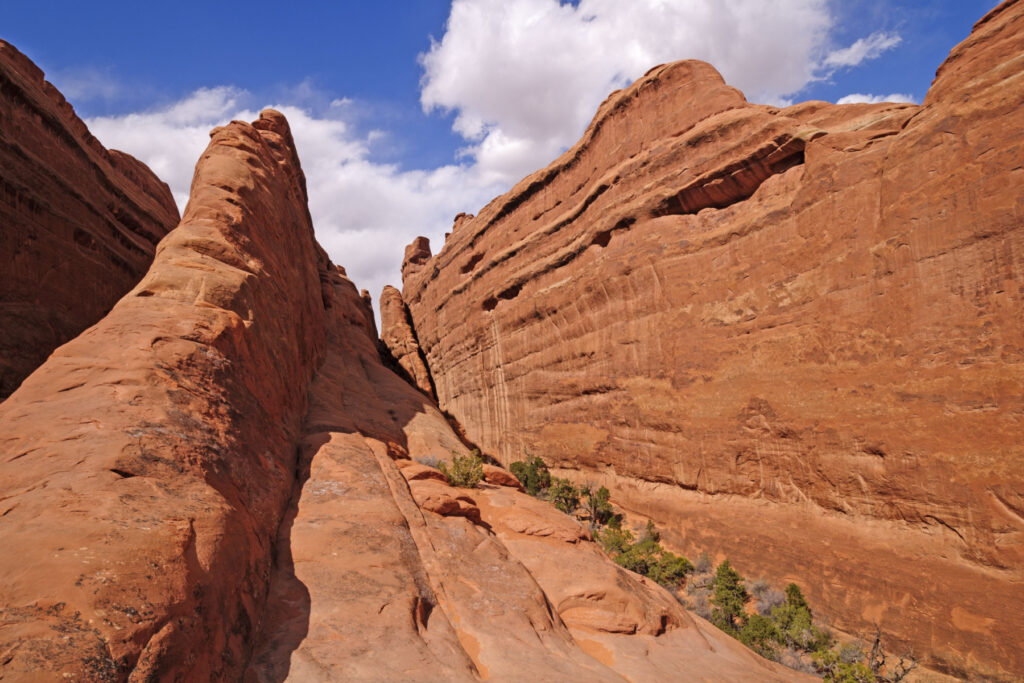
FAQ: Devils Garden Hike in Arches
Arches National Park is home to more than 2,000 arches, some too small to see and others so thin at the top they might not be around much longer.
Arches National Park reports that the full Devils Garden hike takes three to five hours. You can also do an out-and-back hike from various landmarks anywhere from 30 minutes to three hours round trip.
The park is busiest from March through October, but arrive early, and you’ll get the bonus of a sunrise while you on the easiest section of the Devils Garden hike. Summer temperatures soar to 100°+, and hiking midday should be avoided. The night skies are brilliant. Spring hikes bring the potential for wildflowers, while fall brings some of the year’s best weather. Winter gives a new texture to the park, but the Devils Garden hike can be even more treacherous.

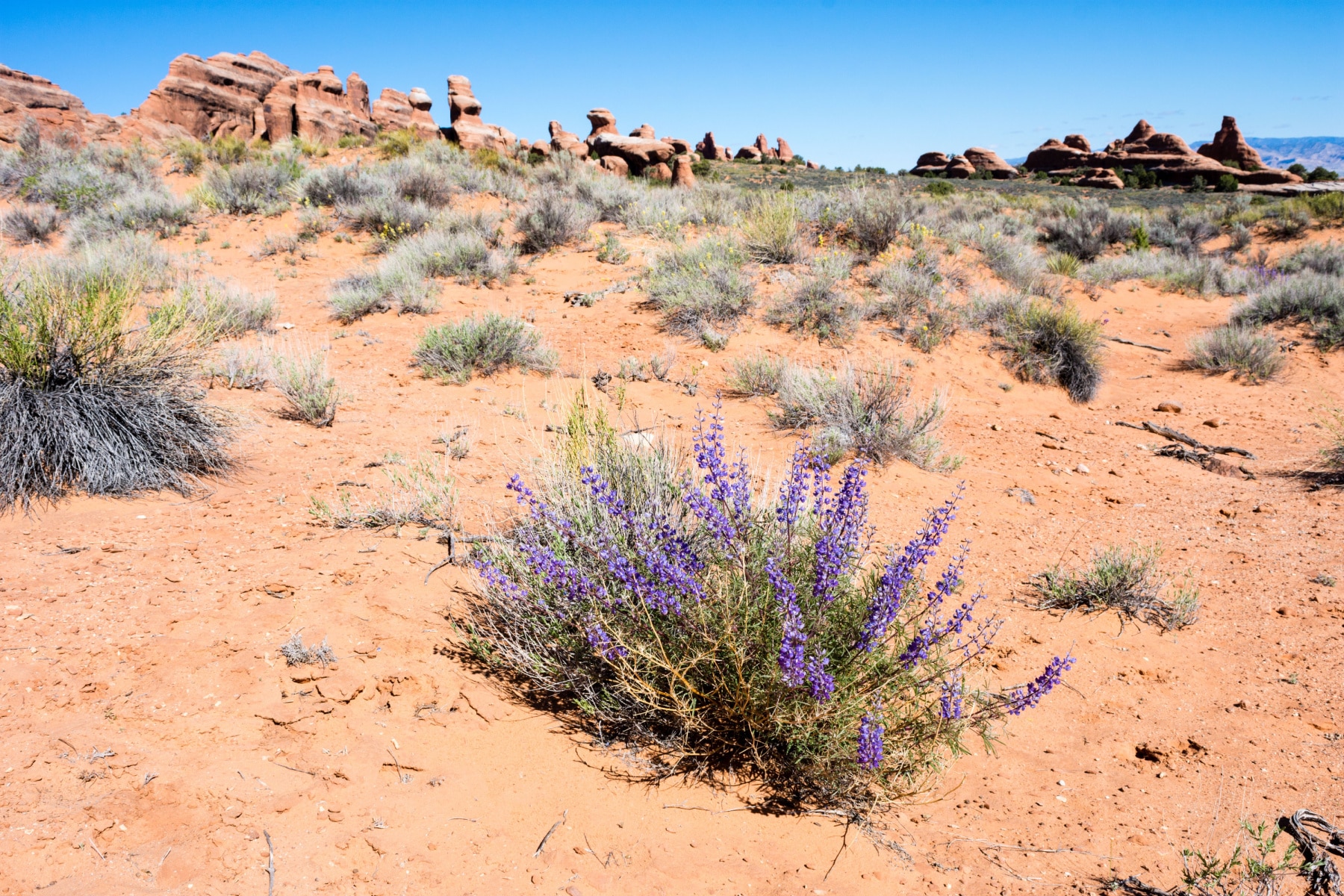
Will Landscape Arch Be Protected from Collapse?
No human interference will be used to prevent arches, like the famed Landscape Arch, from collapsing. When the Landscape Arch rockfall happened in 1991, Noel Poe was the superintendent who firmly stated, “The whole idea of a park is to let natural processes continue. We couldn’t do anything of value anyway, and we may just hasten its falling.”
Arches are designed by nature to collapse as part of the circle of life and elements of nature. While you can help preserve the arches by not walking off the trail or climbing off-limits arches, nature will eventually win.
That’s exactly why we wanted to provide such a detailed guide to the Devil’s Garden hike, so you can appreciate it while it’s still in this stage of erosion.
Pin the Devils Garden Hike in Arches National Park


More Helpful Related Articles
Things to Do Canyonlands: 20 Epic Things to Do in Canyonlands National Park
Bryce Canyon: 20 Epic Things to Do in Bryce Canyon National Park
Things to Do in Zion: 18 EPIC Things to Do in Zion National Park
Road Trip Essentials: 35+ ROAD TRIP ESSENTIALS (You’ll Love + Packing List)
Road Trip Planning Tools: 15 BEST FREE ROAD TRIP PLANNING Tools (& Apps) 2022
Zion National Park Guide: Ultimate Guide to Zion National Park
Best Hikes in Zion: 16 EPIC Hikes in Zion National Park
Things to Do in Arches: 17 EPIC Things to Do in Arches National Park
Devils Garden Hike Arches: Hiking the Epic Devils Garden Trail in Arches
Utah’s Manti-La Sal National Forest: Manti-La Sal National Forest: The Forest As Beautiful as Utah’s Parks
Utah National Parks Guide: 5 MIGHTY Utah National Parks Guide
Utah National Parks Road Trips: 5 Best Utah National Park Road Trips
Arches National Park Facts: 11 Fascinating Arches National Park Facts
Zion National Park Facts: 12 Amazing Zion National Park Facts
Capitol Reef National Park Facts: 15 Incredible Capitol Reef National Park Facts
Bryce Canyon National Park Facts: 15 Interesting Bryce Canyon National Park Facts
Canyonlands National Park Facts: 14 Fascinating Canyonlands National Park Facts
devils garden hike arches, hiking devils garden, devils garden trail, hiking devils garden trail arches national park, hike devils garden arches, devils garden hike arches, hiking devils garden, devils garden trail, hiking devils garden trail arches national park, hike devils garden arches, devils garden hike arches, hiking devils garden, devils garden trail, hiking devils garden trail arches national park, hike devils garden arches, devils garden hike arches, hiking devils garden, devils garden trail, hiking devils garden trail arches national park, hike devils garden arches, devils garden hike arches, hiking devils garden, devils garden trail, hiking devils garden trail arches national park, hike devils garden arches,
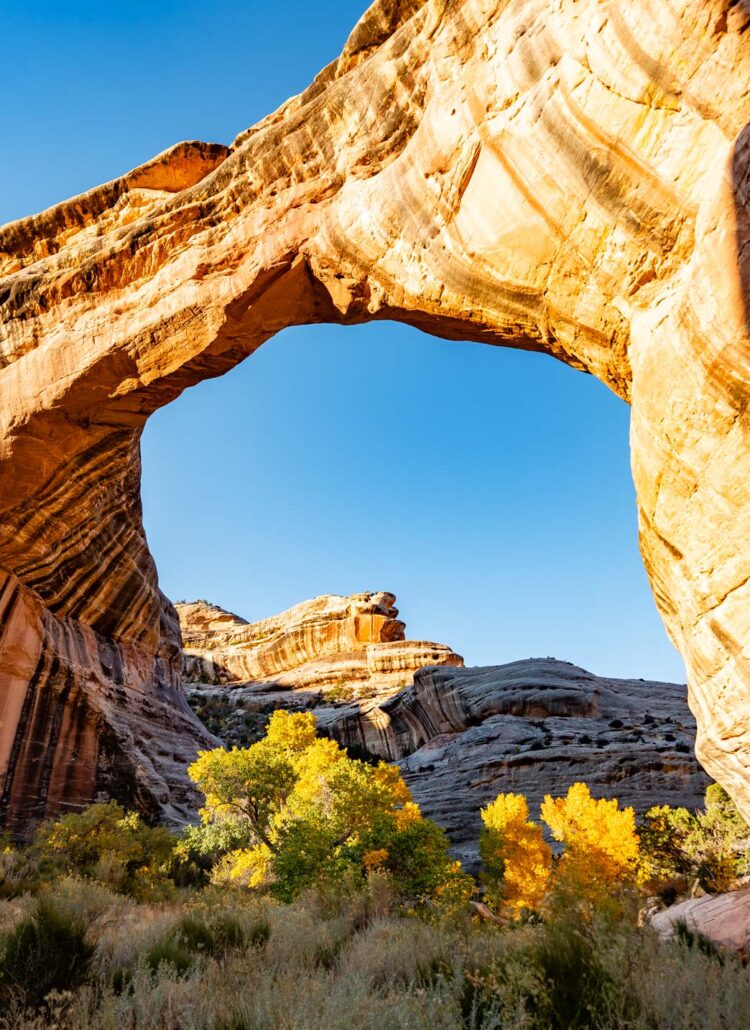

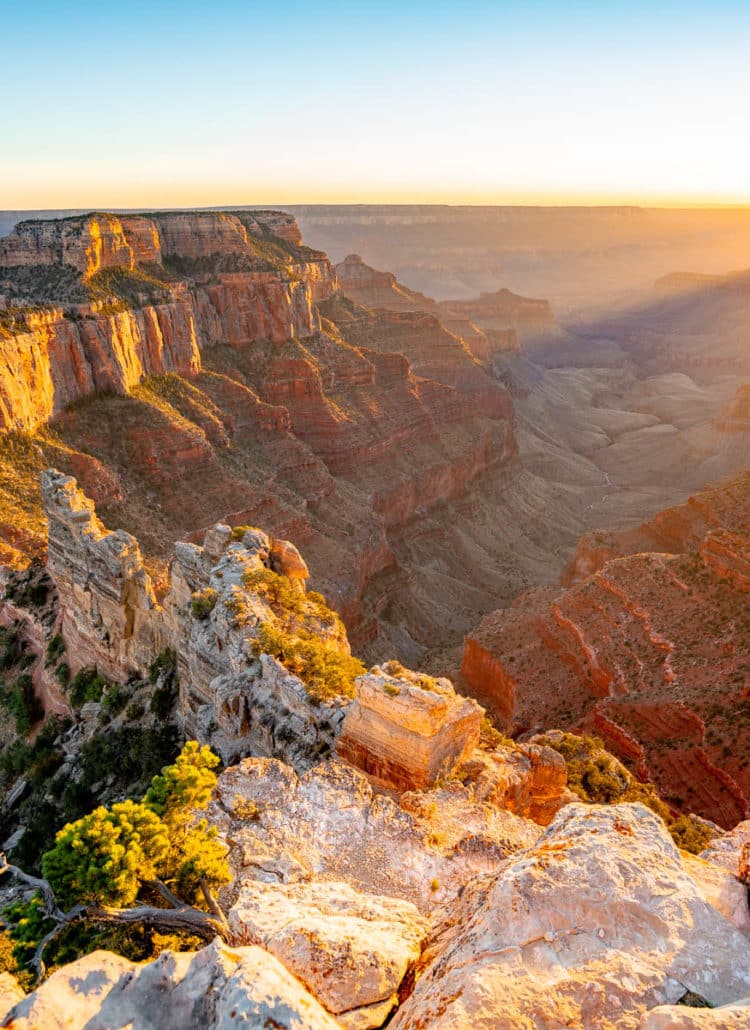


Leave a Reply